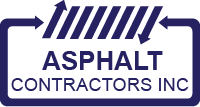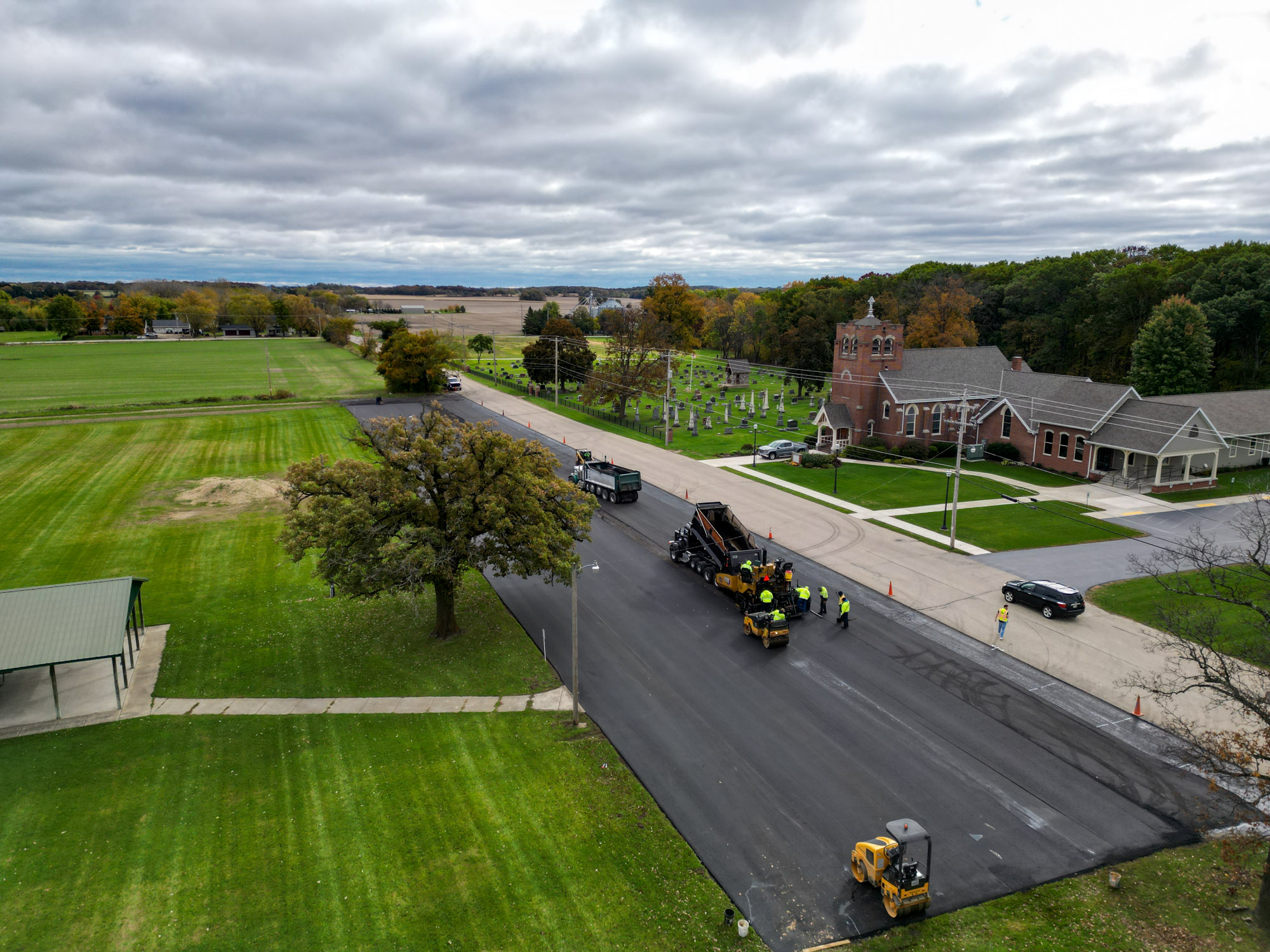Choose the Right Fix for Your Lot

Asphalt parking lot resurfacing keeps your property safe, attractive, and ready for traffic. In Wisconsin, property managers and owners typically compare two proven methods: mill and pave or asphalt overlay. Each has its place, and the best option depends on your pavement’s condition, your budget, and how quickly you need the work done. This guide explains the differences, costs, timelines, and long-term performance so you can make a confident decision. When you are ready, Asphalt Contractors is here to help with a fast, local quote.
What Is Asphalt Parking Lot Resurfacing?
Asphalt parking lot resurfacing restores a worn surface to improve ride quality, safety, and appearance. It does not always mean full reconstruction. Instead, we either add a new layer of asphalt on top of the existing pavement or remove and replace the top layers. The two most common resurfacing methods in Wisconsin are mill and pave and asphalt overlay. Both can extend the life of your parking lot when chosen and installed correctly.
Wisconsin Weather and Your Parking Lot
Our freeze-thaw cycles create special challenges for asphalt. Water seeps into cracks, freezes, and expands, which widens openings and weakens the structure. Snow plows, deicing salt, and heavy loads speed up the wear. If you manage a lot in Racine, Kenosha, Walworth, Waukesha, or Milwaukee counties, you have likely seen these issues firsthand.
- Cracking that spreads and interconnects
- Rutting or depressions in drive lanes
- Ponding water near catch basins and entrances
- Raveling where the surface loosens and aggregates come out
- Oxidation that turns asphalt gray and brittle
Resurfacing addresses many of these problems. The key is to match the technique to the level of distress and the condition of the base layers beneath your pavement.
Mill and Pave vs. Asphalt Overlay: What Is the Difference?
What Is Mill and Pave?
Mill and pave removes the top layer or layers of asphalt with a milling machine, typically 1 to 4 inches, and then installs new asphalt to restored grades. Milling follows existing contours while improving drainage and transitions. This method keeps the base and subbase intact if they are sound, but it allows us to correct many surface-level failures.
- Pros: Removes damaged surface, corrects elevations, improves drainage, compatible with fabric membranes, longer service life than a thin overlay
- Best for: Lots with moderate to severe surface distress, ruts or shoving, poor drainage, or where raising the surface height is not allowed at doors, curbs, or ADA ramps
What Is an Asphalt Overlay?
An asphalt overlay places a new layer, usually 1.5 to 2 inches, directly over the existing pavement after cleaning and minor repairs. It is faster and usually less expensive than mill and pave. However, overlays do not remove existing height issues, and severe cracks or base failures will reflect through the new layer if not treated.
- Pros: Budget friendly, quick installation, minimal disruption to business
- Best for: Lots with a stable base, limited cracking, no significant rutting, and room to raise heights at transitions without creating trip hazards or drainage problems
Cost Comparison in Wisconsin
Actual pricing depends on size, layout, condition, and project scope. The following ranges are typical for Southeast Wisconsin and can help with early budgeting. Asphalt Contractors manufactures our own asphalt, which helps control costs and maintain mix quality during your project.
- Asphalt overlay: About $2.50 to $5.50 per square foot depending on thickness, surface prep, and striping needs
- Mill and pave: About $4.50 to $9.50 per square foot depending on milling depth, base repairs, thickness, and traffic control
Larger projects see lower per-square-foot costs. Small or highly phased projects may cost more due to setup time and traffic control. If ADA upgrades, catch basin rebuilds, or undercut repairs are needed, they will add to the total. The best way to refine these numbers is a site visit. Asphalt Contractors offers clear, itemized proposals so you can choose the right scope.
Cost Drivers to Consider
- Size and shape of the lot and number of mobilizations
- Depth of milling and number of asphalt lifts required
- Extent of patching, dig-outs, or base stabilization
- Drainage corrections or curb and inlet repairs
- Access constraints and after-hours or weekend work
- Markings, signage, and specialty coatings
Timeline and Business Disruption
Parking lot downtime matters. Here is what most Wisconsin property managers can expect from each method.
- Overlay: Often 1 to 3 days for mid-size lots depending on prep, striping, and weather. Typical reopen time for light traffic is 24 hours in warm weather and 24 to 48 hours in cooler months.
- Mill and pave: Usually 3 to 7 days for mid-size lots depending on milling depth, repairs, and phasing. Reopen times are similar once the final lift cools and striping is complete.
Asphalt Contractors works around your peak hours. We can phase the lot to keep key entrances open, schedule night or weekend work, and coordinate with your tenants. Our crews bring the right equipment and staffing levels to finish efficiently while maintaining quality.
Durability and Lifespan
Service life depends on traffic, weather, drainage, and maintenance. As a general guide in Southeast Wisconsin:
- Asphalt overlay: 8 to 12 years with timely crack sealing and sealcoating
- Mill and pave: 12 to 20 years, especially when drainage is improved and routine care is performed
To get the most out of your investment, Asphalt Contractors can set up a maintenance plan. A well-timed crack seal program prevents water from entering and expanding during winter. Sealcoating protects the surface from oxidation and salt. Prompt patching stops isolated failures from growing.
How to Decide: A Simple Decision Guide
Use these quick checks to steer your choice for asphalt parking lot resurfacing.
- If your lot has widespread alligator cracking, rutting, or standing water, lean toward mill and pave or targeted dig-outs before an overlay.
- If the surface is mostly sound with mild to moderate wear, an overlay may provide strong value.
- If door thresholds, curb heights, or ADA ramps would be compromised by added thickness, mill and pave is safer.
- If you need to reset slopes toward drains, milling provides better control than an overlay alone.
- If budget and speed are top priorities and the base is stable, an overlay can be the right move.
- Schedule a site evaluation with Asphalt Contractors
- Confirm pavement structure and base condition with cores if needed
- Review drainage patterns and ADA slopes
- Identify any required repairs at catch basins and curbs
- Choose phasing to minimize business impact
- Finalize scope: overlay, mill and pave, or a hybrid approach
Our Process at Asphalt Contractors
Asphalt Contractors Inc., established in 1979 in Union Grove, has delivered thousands of successful asphalt parking lot resurfacing projects across Southeast Wisconsin. Our in-house asphalt plant, certified crews, and modern equipment help us complete work quickly, safely, and to spec.
Site Evaluation and Quote
Every project starts with a walk-through. We look for structural cracking, rutting, drainage issues, and safety concerns. When needed, we recommend core sampling to confirm layer thickness and base condition. You receive an itemized proposal that explains options and timelines, so you can choose the best path forward.
Mill and Pave Workflow
- Traffic control and phasing plan to maintain access
- Precision milling at specified depths to remove damaged layers
- Base inspection and localized repairs or undercuts if required
- Tack coat for proper bonding to the milled surface
- Paving new asphalt lifts to restore profile and slopes
- Compaction with vibratory rollers and plate compactors near edges
- Quality checks for density, smoothness, and joint tightness
- Final striping and signage installation
Overlay Workflow
- Thorough cleaning and removal of loose material
- Crack filling and leveling course for low spots or birdbaths
- Optional geotextile interlayer to reduce reflective cracking
- Tack coat application for strong adhesion
- Placement of 1.5 to 2 inches of hot-mix asphalt
- Careful compaction and joint finishing
- Tie-ins at aprons, concrete, and curb lines to prevent trip edges
- Striping according to your layout or updated plan
Quality and Safety
- In-house asphalt manufacturing for consistent mix quality
- Experienced, certified crews and maintained equipment
- Adherence to Wisconsin specs for compaction and thickness
- Clear communication and site safety throughout the project
Compliance, Drainage, and Accessibility
Resurfacing is the ideal time to address drainage and accessibility. Small adjustments now prevent costly callbacks later. Asphalt Contractors coordinates these details during design so your lot functions well and meets standards.
- Set slopes to direct water to catch basins and away from entrances
- Check and rebuild basin castings, concrete collars, or frames as needed
- Verify ADA slopes for stalls, access aisles, and routes
- Review transitions at sidewalks, doors, and curb ramps
- Update stall count, signage, and striping to current code
Common Questions About Asphalt Parking Lot Resurfacing
Can I overlay areas with severe alligator cracking?
Not without repairs. Alligator cracking signals structural failure. Those areas need full-depth patching or dig-outs before an overlay. Otherwise, cracks will reflect through the new surface within a season or two.
How thick should an overlay be?
Most overlays for commercial lots in Wisconsin are 1.5 to 2 inches compacted. Heavier traffic lanes may benefit from 2 inches or a leveling course plus 1.5 inches on top. Your site conditions determine the best thickness.
When is full reconstruction better than resurfacing?
If more than 30 to 40 percent of the lot shows structural failure or the base is weak, full-depth reclamation or reconstruction is often more cost effective than repeated patching. Asphalt Contractors can evaluate and provide both resurfacing and reconstruction options.
What months can you pave in Wisconsin?
Prime paving season is typically April through November, depending on temperatures. Spring and fall are excellent for compaction. Early spring and late fall work may require adjusted schedules to ensure proper curing.
How soon can I sealcoat after resurfacing?
Wait 3 to 6 months before sealcoating a new surface. This allows the asphalt to cure and release light oils. After that, sealcoating every 2 to 3 years extends the life of your investment.
Why Choose Asphalt Contractors
Asphalt Contractors Inc. has served Wisconsin since 1979 with complete paving, maintenance, milling and pulverizing, concrete construction, site preparation, asphalt manufacturing, and crushing. Because we manufacture our own asphalt, we control mix quality and availability, which keeps your project on schedule and on budget. Our commitment to excellence shows in our trained crews, reliable equipment, and clear communication from start to finish. We proudly serve Racine, Kenosha, Walworth, Waukesha, and Milwaukee counties.
- Local experience with Wisconsin weather and soils
- Accurate estimates and practical recommendations
- Efficient phasing to reduce downtime for businesses and tenants
- High-quality materials produced in-house for consistency
- Full-service partner for paving, concrete, maintenance, and repairs
Overlay or Mill and Pave: Which Should You Choose?
If your lot is structurally sound and you need a fast refresh, an overlay offers a strong value. If you have drainage problems, ruts, or height constraints at doors and ramps, mill and pave gives longer-term performance and better control. Many projects use a hybrid approach: mill and pave in drive lanes and bad areas, then overlay the rest to balance cost and durability.
Next Steps: Get a Local, No-Pressure Quote
Ready to evaluate asphalt parking lot resurfacing for your property in Southeast Wisconsin? Asphalt Contractors makes it simple. We will walk your site, listen to your goals, and provide clear options that fit your budget and schedule. Ask about night or weekend work, phased plans to keep entrances open, and bundled maintenance to protect your new surface. Contact Asphalt Contractors today to schedule your onsite evaluation and get a detailed, no-pressure quote. Let us help you choose the right solution, whether


